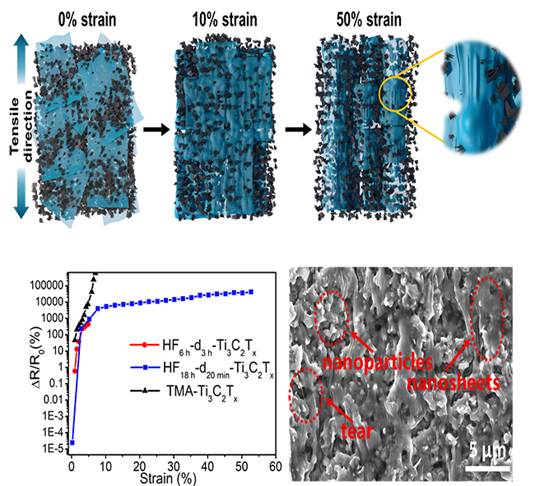Shanghai Institute of Ceramics has made important progress in the research of flexible strain sensitive materials
With the development of flexible electronics, lightweight, portable, foldable and wearable flexible devices have gradually become a research hotspot. Among them, flexible strain sensor is the most widely used flexible electronic device, and has broad application prospects in motion sensing, health monitoring, medical diagnosis and so on. The basic principle of the strain sensor is to convert the strain change of the device into an electrical signal for output, which is used to monitor the stress signal causing strain. Sensitivity (i.e., gauge factor (GF)) and stretchability are two crucial parameters used to evaluate the sensing performance of strain sensors. A high sensitivity is required for subtle deformations, such as the pulse and heartbeat. Meanwhile, a high stretchability is fundamental for detecting substantial body motions induced by joint movements. In general, to meet the basic requirements of full-range human motion detection, it is essential for a strain sensor to have a sensing range over 50% and a gauge factor larger than 100 in the full working range simultaneously. However, enhancements in sensitivity and working range are contradictory because the sensitivity requires a significant structural change under a small strain, while stretchability requires the device to maintain the connectivity of conductive pathways in a large strain region; thus, the fabrication of an ideal strain sensor still faces great challenges.
Recently, the research team led by Jing Sun, a researcher at the Shanghai Institute of Ceramics, Chinese Academy of Sciences, used Ti3C2Tx (MXene) as the research object and successfully constructed a unique Ti3C2Tx nanoparticle-nanosheet hybrid network based strain sensors. The synergetic motion of the Ti3C2Tx nanoparticles and nanosheets endowed the strain sensor with a high sensitivity (GF > 178.4) over the full broad range (0-53%), a very low detection limit (0.025%), a good cycling durability (over 5000 cycles) and the ability to accurately detect the physiological signals of human, like respiratory, pulse and so on. Besides, a constrained microcrack propagation mechanism is proposed for the first time, which provides a new idea for the design of high performance flexible strain sensor. The relevant research results were published in Advanced Functional Material 2019, 1807882, with Yina Yang as the first author and Ranran Wang and Jing Sun as the co-corresponding authors.
Article links: https://onlinelibrary.wiley.com/doi/full/10.1002/adfm.201807882




